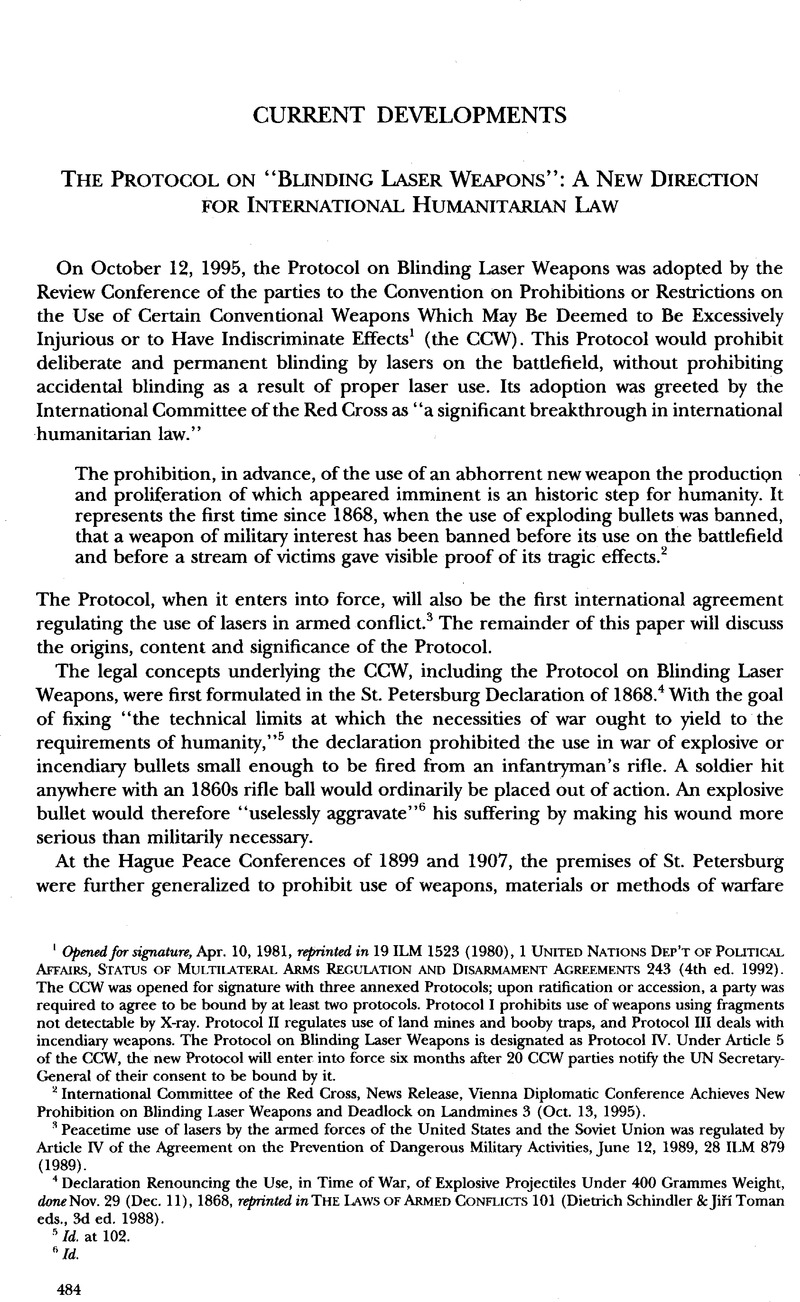Article contents
The Protocol On “Blinding Laser Weapons”: A New Direction for International Humanitarian Law
Published online by Cambridge University Press: 27 February 2017
Abstract

- Type
- Current Developments
- Information
- Copyright
- Copyright © American Society of International Law 1996
References
1 Opened for signature, Apr. 10, 1981, reprinted in 19 ILM 1523 (1980), 1 United Nations Dep’t of Political Affairs, Status of Multilateral Arms Regulation and Disarmament Agreements 243 (4th ed. 1992). The CCW was opened for signature with three annexed Protocols; upon ratification or accession, a party was required to agree to be bound by at least two protocols. Protocol I prohibits use of weapons using fragments not detectable by X-ray. Protocol II regulates use of land mines and booby traps, and Protocol III deals with incendiary weapons. The Protocol on Blinding Laser Weapons is designated as Protocol IV. Under Article 5 of the CCW, the new Protocol will enter into force six months after 20 CCW parties notify the UN Secretary-General of their consent to be bound by it.
2 International Committee of the Red Cross, News Release, Vienna Diplomatic Conference Achieves New Prohibition on Blinding Laser Weapons and Deadlock on Landmines 3 (Oct. 13, 1995).
3 Peacetime use of lasers by the armed forces of the United States and the Soviet Union was regulated by Article IV of the Agreement on the Prevention of Dangerous Military Activities, June 12, 1989, 28 ILM 879 (1989).
4 Declaration Renouncing the Use, in Time of War, of Explosive Projectiles Under 400 Grammes Weight, done Nov. 29 (Dec. 11), 1868, reprinted in The Laws of Armed Conflicts 101 (Dietrich Schindler &Jiří Toman eds., 3d ed. 1988).
5 Id. at 102.
6 Id.
7 Regulations annexed to the Convention with Respect to the Laws and Customs of War on Land, July 29, 1899, Art. 23(e), 32 Stat. 1803, 1 Bevans 247.
8 Regulations annexed to the Convention Respecting the Laws and Customs of War on Land, Oct. 18, 1907, Art. 23(e), 36 Stat. 2277, 1 Bevans 631. “Superfluous injury” and “unnecessary suffering” are alternative English translations of the phrase “maux superflus” in the authentic French texts of both the 1899 and the 1907 Regulations. The most recent codification of this principle adopts both phrases, prohibiting weapons, etc., “of a nature to cause superfluous injury or unnecessary suffering.” Protocol Additional to the Geneva Conventions of 12 August 1949, and Relating to the Protection of Victims of International Armed Conflicts, Dec. 12, 1977, Art. 35(2), 1125 UNTS 3, 16 ILM 1391 (1977). See also New Rules for Victims of Armed Conflicts 195–96 (Michael Bothe, Karl Josef Partsch & Waldemar A. Solf eds., 1982) [hereinafter New Rules].
9 Ann Van Wynen Thomas & A. J. Thomas, Legal Limits on the Use of Chemical and Biological Weapons 199 (1970).
10 Statement by Ronald J. Bettauer to Lucerne Conference (Sept. 25, 1974), in 1974 U.S. Digest 707.
11 See, e.g., New Rules, supra note 8, at 196–97; Bettauer, supra note 10, at 707–08; Thomas & Thomas, supra note 9, at 198.
12 See, e.g., Mark Hewish, Battlefield Lasers: The Race between Action and Countermeasure, Int’l Def. Rev., Feb. 1995, at 39; Steven Zaloga, Soviets Close to Deploying Battlefield Beam Weapons, Armed Forces J. Int’l, May 1990, at 28; Fermin Gallego & Mark Daly, Laser Weapon in Royal Navy Service, in Blinding Weapons 170 (Louise Doswald-Beck ed., 1993).
13 See, e.g., Gerhard Schaerer, The Laser as an Anti-Personnel Weapon, in Bunding Weapons, supra note 12, at 22, 22–26.
14 Memorandum of Law, 29 September 1988, Subject: use of lasers as antipersonnel weapons, reprinted in Blinding Weapons, supra note 12, at 367.
15 See, e.g., Int’l Committee of the Red Cross, Blinding Weapons (ICRC campaign brochure, 1995); Human Rights Watch Arms Project, United States/U.S. Bunding Laser Weapons (1995).
16 See, e.g., Blinding Weapons: Explanatory Memorandum to the Proposal for a Prohibition, Submitted by Sweden to the Group of Government Experts to Prepare the Review Conference on the Convention on Prohibitions or Restrictions on the Use of Certain Conventional Weapons Which May Be Deemed to Be Excessively Injurious or to Have Indiscriminate Effects, Conf. Doc. CCW/CONF.I/GE/14 (1994); Pepp Algvere, The Devastating Effects of High-Power Lasers to the Human Eye, in Blinding Weapons, supra note 12, at 158; Bengt Anderberg & Myron Wolbarsht, Blinding Lasers: The Nastiest Weapon?, in id. at 161.
17 Reports of papers read to, discussions at, and documents submitted to these meetings are published in Blinding Weapons, supra note 12.
18 Conf. Doc. CCW/CONF.I/GE/14, supra note 16, at 4.
19 Peter Felstead, China Markets Blinding Laser, Jane’s Intelligence Rev., June 1995, at 1.
20 Office of Assistant Secretary of Defense (Public Affairs), Press Release No. 482–95, DOD Announces Policy on Blinding Lasers (Sept. 1, 1995).
21 See UN Information Service, Press Release DC/2535, Review Conference of States Parties to Conventional Weapons Convention, Vienna, 25 September-13 October—Adopts Ban on Use, Transfer of Blinding Laser Weapons (Oct. 17, 1995). Article 8 of Appendix A to the CCW states, inter alia, that “a conference may agree upon amendments which shall be adopted and shall enter into force in the same manner as this Convention and the annexed Protocols,” i.e., by consensus.
22 Review Conference of the States Parties to the Convention on Prohibitions or Restrictions on the Use of Certain Conventional Weapons Which May Be Deemed to Be Excessively Injurious or to Have Indiscriminate Effects, Additional Protocol to the Convention on Prohibitions or Restrictions on the Use of Certain Conventional Weapons Which May Be Deemed to Be Excessively Injurious or to Have Indiscriminate Effects, Conf. Doc. CCW/CONF.I/7 (1995).
23 See Felstead, supra note 19, at 1.
24 See id.
* Senior Analyst, and Defense Analyst, SAIC, McLean, Va., respectively.
- 11
- Cited by


